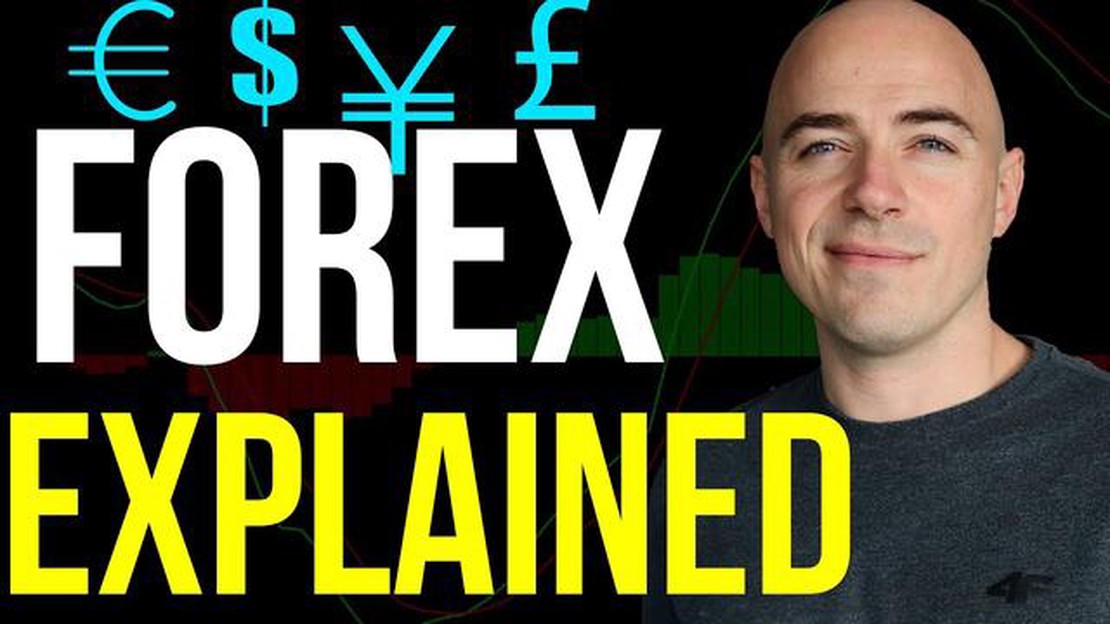Exploring the Connection Between EPS and Stock Price for Investors
What is the relationship between EPS and stock price? Investors are constantly seeking ways to predict future stock price movements and make …
Read Article
Forex is short for Foreign Exchange, and it refers to the global market where currencies are bought and sold. Forex trading is the process of speculating on the price movements of different currencies, with the goal of making a profit. This market is the largest and most liquid in the world, with daily trading volumes exceeding $5 trillion.
In forex trading, currencies are always traded in pairs. For example, you might trade the Euro against the US Dollar, or the Japanese Yen against the British Pound. When you buy one currency, you are simultaneously selling another. The exchange rate between the two currencies determines the value of the trade.
Forex trading takes place in a decentralized market, meaning that there is no central exchange or regulator. Instead, trading is conducted over the counter (OTC) through a network of banks, financial institutions, and individual traders. This means that forex trading can take place 24 hours a day, five days a week, allowing for round-the-clock trading opportunities.
So, how does forex trading work? Traders speculate on the direction in which they think a currency will move, and they can profit by either buying or selling that currency. For example, if you think the Euro will appreciate against the US Dollar, you would buy Euros and sell US Dollars. If your prediction is correct, and the Euro does indeed increase in value, you can sell it back at a higher price, making a profit.
Forex trading, also known as foreign exchange or FX trading, is the buying and selling of currencies on the foreign exchange market. It is the largest and most liquid financial market in the world, with trillions of dollars being traded daily.
In forex trading, traders speculate on the price movements of different currencies by buying one currency and selling another at the same time. The objective is to profit from the changes in exchange rates between currency pairs.
Forex trading involves a decentralized global network of traders, banks, institutions, and brokers that facilitate the buying and selling of currencies 24 hours a day, five days a week.
Unlike other financial markets, such as the stock market, forex trading does not have a central exchange. Instead, it operates through an electronic network of banks, corporations, and individual traders, known as the Interbank market.
The forex market is open from Sunday night to Friday night, allowing traders from around the world to participate in trading activities at any time. This accessibility and flexibility make forex trading a popular choice for traders looking for opportunities to profit from currency fluctuations.
Forex trading provides a range of benefits, including high liquidity, low transaction costs, leverage, and the ability to trade on both rising and falling markets. However, it is important for traders to understand the risks involved and to have a solid trading strategy in place.
In conclusion, forex trading is the buying and selling of currencies in the global foreign exchange market. It presents opportunities for individuals and institutions to profit from currency fluctuations, but it also carries risks. Successful forex trading requires knowledge, experience, and a disciplined approach to risk management.
Currency exchange is the process of converting one currency into another at a specific exchange rate. It is an essential component of international trade and finance, allowing businesses and individuals to buy and sell goods and services across borders.
Read Also: Disadvantages of EWMA: Explained in Detail
Here are some key aspects of currency exchange:
Understanding the basics of currency exchange is essential for individuals and businesses involved in international transactions. It allows them to navigate the complexities of the forex market and make informed decisions when buying or selling currencies.
Forex trading, also known as foreign exchange trading, involves buying one currency and selling another at the same time. Traders in the forex market aim to profit from the fluctuating exchange rates between different currencies. Here’s how forex trading works:
Read Also: Understanding Payment for Order Flow: What It Is and How It Works4. Leverage and margin: Forex trading allows traders to use leverage, which allows them to control larger positions with a small amount of capital. Leverage is expressed as a ratio, such as 1:50 or 1:100. Margin is the amount of money that traders need to deposit in their trading account in order to open and maintain a leveraged position. 5. Market participants: Forex trading is conducted through an interbank market, where large financial institutions trade currencies. Individual traders can access the forex market through brokers, who act as intermediaries between traders and the interbank market.
 6. Market hours: The forex market is open 24 hours a day, five days a week. It starts on Sunday evening (EST) with the opening of the Asian session and ends on Friday evening (EST) with the closing of the US session. This allows traders from around the world to trade at any time.
7. Fundamental and technical analysis: Forex traders use different strategies to analyze the market and make trading decisions. Fundamental analysis involves analyzing economic and political factors that can affect currency prices, while technical analysis involves studying charts and using indicators to identify patterns and trends.
8. Risk management: Like any form of trading, forex trading involves risks. Traders use risk management techniques, such as setting stop-loss orders and managing their positions properly, to limit potential losses.
9. Trading platforms: Traders can execute trades and monitor the forex market through trading platforms provided by brokers. These platforms offer real-time price quotes, charts, technical indicators, and other tools necessary for trading.
6. Market hours: The forex market is open 24 hours a day, five days a week. It starts on Sunday evening (EST) with the opening of the Asian session and ends on Friday evening (EST) with the closing of the US session. This allows traders from around the world to trade at any time.
7. Fundamental and technical analysis: Forex traders use different strategies to analyze the market and make trading decisions. Fundamental analysis involves analyzing economic and political factors that can affect currency prices, while technical analysis involves studying charts and using indicators to identify patterns and trends.
8. Risk management: Like any form of trading, forex trading involves risks. Traders use risk management techniques, such as setting stop-loss orders and managing their positions properly, to limit potential losses.
9. Trading platforms: Traders can execute trades and monitor the forex market through trading platforms provided by brokers. These platforms offer real-time price quotes, charts, technical indicators, and other tools necessary for trading.
Overall, forex trading is a decentralized market where participants trade currencies with the aim of making profits. Understanding how forex trading works and developing a trading strategy can help traders succeed in this dynamic and potentially lucrative market.
Forex trading, also known as foreign exchange trading, is the buying and selling of currencies on the foreign exchange market. It involves the simultaneous buying of one currency and selling of another with the aim of making a profit from the fluctuations in their exchange rates.
Forex trading works through a global network of banks, corporations, and individual traders exchanging one currency for another. The market is open 24 hours a day, five days a week, allowing traders to trade currencies at any time. Trades are conducted in pairs, with the exchange rate determining the value of one currency against another. Traders can profit by speculating on whether a currency will rise or fall in value.
Forex trading involves financial risk, like any other form of investing or trading. The risks include market volatility, leverage risks, interest rate risks, and counterparty risks. Market volatility can cause rapid and substantial losses if the market moves against your position. Leverage allows traders to control a large amount of currency with a smaller initial investment, but it also magnifies both potential profits and losses. Interest rate changes can also affect currency values, and traders must keep an eye on economic indicators and news events that may impact the market. Finally, counterparty risks refer to the risk of the other party not fulfilling their financial obligations.
Forex trading can be suitable for beginners, but it requires a solid understanding of the market and a well-developed trading strategy. It is essential for beginners to educate themselves about the basics of forex trading, including how the market works, risk management, and technical analysis. Beginners should start with a demo account to practice trading without risking real money and gradually transition to live trading once they have gained experience and confidence.
What is the relationship between EPS and stock price? Investors are constantly seeking ways to predict future stock price movements and make …
Read ArticleWarrants vs Stock Options: Understanding the Difference Warrants and stock options are both financial instruments that give the holder the right to …
Read ArticleIs Deriv regulated in USA? Deriv is a popular online trading platform that provides access to a wide range of financial instruments. If you are …
Read ArticleIs scalping good in options trading? Scalping refers to a trading strategy that involves making small, quick trades in the financial markets to profit …
Read ArticleHow much does Interactive Brokers charge for SPX options? Interactive Brokers is a popular online brokerage firm known for its low commission rates …
Read ArticleIs Golden Cross a good strategy? When it comes to trading strategies, the golden cross is one that has gained significant attention in the financial …
Read Article